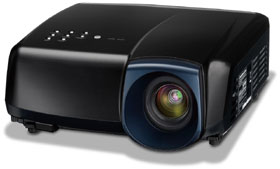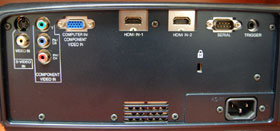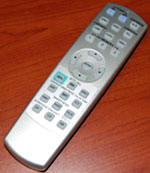 |
; |
Verdict: HIGHLY RECOMMENDED AT A GLANCE
Mitsubishi HC5500 Highlights:
MSRP: $2399.99 (USD) If you’re looking for a quality home theater projector, the HC5500 from Mitsubishi delivers performance in spades, and based on price-point alone reveals itself as one of the better entries in the 1080p projector category. FIRST IMPRESSIONS - Mitsubishi HC5500 Home Theater LCD ProjectorStyle & Appearance In terms of styling and design, the HC5500 comes in a highly desirable black color chassis and favors a square-ish, straight edges look with the corners offering some subtle contours that keep it looking relatively modern. While compact and narrow, the projector comes off looking higher than it actually is, and while certainly an acquired taste in terms of overall appearance, it does tend to grow on you. It’s relatively lightweight, tipping the scales at 12.3 pounds (5.6 kgs.), with dimensions of (W x H x D): 13.1 x 4.9 x 13.9 inches. The lens is slotted on the far right of the projector and features a large protective housing. Up top and to the left, you’ll find all of the button controls that include Power, Menu, Zoom/Focus, Lens Shift, and directional keys. Looking at the projector head-on, up front and to the right, you’ll find the air inlet, and just across the way to the left, you’ll find the air outlet. Two height adjustable legs can be found up front on either side, while the rear features all of the inputs which we'll discuss in greater detail just down below. Getting Connected In terms of connectivity, the HC5500 is equipped for all of your HD, home theater needs with a clean, clearly labeled layout. The inputs include HDMI 1.3 (2), and one each of the following: Component, S-Video, Composite, RGB, RS-232C, and a Trigger Out. Remote Control
PERFORMANCE - Mitsubishi HC5500 LCD ProjectorSet-Up Similar to the HC1600 (though the HC5500 does feature a vertical lens shift of 50%), the HC5500 comes with a limited zoom (1.2:1) lens. As opposed to manual functionality that you’ll find on many projectors, all of the zoom, focus, and lens shifting is motorized. While I personally prefer doing my zooming and focusing and lens shifting manually, this is all a matter of preference. And one major plus that these motorized controls offer is the ability to be more precise since each press of the button can adjust things equally and incrementally every time (Step Mode), giving you just a little more control. And for those that prefer things quick and fast, the default speed mode for adjustments is Fast. While the limited zoom on the lens does require slightly more effort to set-up, being that this is a home theater projector, once you’ve done the initial work, you’ll likely never need to do it again. With respect to the user menus, the HC5500 has five: Image, Installation, Feature, Signal, and Information. From a layout and functionality standpoint, the user menus for the HC5500 give you all of the controls and adjustment options you can think of: all the basics in the Image menu such as tweaking the contrast, brightness, color, sharpness, and color temperature, to the more advanced image options such as RGB contrast and brightness, along with gamma adjustments for various picture preset reference modes. Speaking of picture presets, the HC5500 offers four: Auto, Sports, Video, and Cinema which can be accessed by scrolling left to right in the Gamma Mode section from the Image menu. If you hit enter in Gamma Mode, you’ll bypass the presets and advance into the video reference adjustments. While this can be somewhat confusing at first, as you begin to explore and navigate your way through the menus, you’ll find them to be easy and logically laid out. And for those of you who wish to save customized settings based on what you happen to be watching, the HC5500 allows you to save up to three. The remaining four menus contain the usual mix of options that range from Cinema Mode, Password Function, Over Scan, and menu dimmer and positioning. All in all, Mitsubishi has done a tremendous job striking that ideal balance between easy to use and highly functional, so whether you prefer to do the bare minimum or you want to adjust until you’re blue in the face, you’ll find exactly what you need here. Out-Of-Box Picture Via an HDMI, 1080p connection, initial testing was done using out-of-box settings with the Pioneer BDP-51FD Blu-ray player and BBC’s Planet Earth as the Blu-ray disc subject. With all that high-end video processing under the hood, it’s no wonder that HC5500 impressed more than most out of the gate. Colors were bright, sharp, and vivid, contrast was good, and black levels were nice. I then adjusted as follows:
In addition to the above changes made in the Image Menu, I also adjusted the Lamp Mode (Installation menu) from Standard (default) to Low. Armed with said changes, the noticeable areas of improvement were contrast detail and black levels. I was also impressed by how natural and film-like everything looked. While LCD is sometimes unfairly knocked for looking too “digital,” the HC5500 projector manages to avoid such criticism, delivering smooth, rich, and finely textured images. In addition to exceptional image quality, one thing you’ll notice (or likely not notice) is just how whisper quiet it is during operation. Rated at 19 dBA in Low mode, you won’t even know it’s on during usage. Of all the projectors I’ve tested thus far, the HC5500 rates as the quietest yet. Another thing you’ll likely notice is just how hot this runs during extended usage. Is it San yo PLV-Z60 hot? No projector I’m aware of is that scorchingly hot, but be mindful that it does generate slightly above-average heat and it’s probably a good idea to keep its immediate area clear and free of any unnecessary clutter. Calibration It was now time to perform a calibration on the HC5500 specific to a darkened, home theater room. Pre-calibration color temperature across the IRE board indicated what was already apparent out of the box: the HC5500 is an impressive projector, and save for the 30 and below and the 80 and above IRE ranges which favored a red and blue push respectively; this projector was relatively tight to our ideal post-calibrated color temperature of 6500K. Some artful RGB tweaking in the brightness and contrast sections of the color temperature sub-menu using Medium as color reference was done, and subsequent calibrated numbers indicated that color temperature figures across the IRE range were a lot tighter to the target color temperature. Another calibration was done (bright room), and this proved to be far more difficult due to the extremely biased conditions of the room which, fused with seven pot lights, favored a huge red push, completely overwhelming the projector (or any projector, for that matter) in the mid-high to lower IRE ranges. So much so, that only the 80 IRE range was close to the 6500K color temperature, while 70, 90, and 100 were the next best, though still off the mark by some 500K above or below. Post-calibration yielded better numbers across the board, with an average 500K increase which hit its peak in the 70 IRE range offering up an almost perfect color temperature of 6493K. Practically speaking, bright room calibrations are far more subjective than dark room calibrations because there are so many elements that can differ from room to room: types of lights, amount of lights, windows, and even the color of the walls. With a dark room, which is always the ideal viewing scenario for enjoying a home theater projector anyway, you essentially eliminate all of the extraneous elements and thus, can better evaluate and focus on the projector itself. For your viewing/using pleasure, here are the calibrated dark room settings:
Via the Color Temperature menu, the below RGB adjustments for ideal, 6500K white balance were made:
And also for your viewing/using pleasure, here are the calibrated bright room settings:
And the RGB adjustments were:
Revisiting various scenes from Planet Earth revealed an image that appeared to exhibit a greater degree of contrast, more accurate color saturation, and marginally deeper blacks. I will however say that based on dark room viewing, a few simple adjustments via the user menu will give you a terrific picture that can more than stand on its own, making a professional calibration more of an option than an absolute necessity. FINAL THOUGHTS - Mitsubishi HC5500 Home Theater LCD ProjectorBased on price and performance – limited zoom lens and lack of a horizontal lens shift notwithstanding – the HC5500 from Mitsubishi scores very high marks for image quality that benefits from some top-notch video processing that this 1080p projector takes full advantage of. Throw in a long-life lamp of up to 5000 hours with an an easy-to-use, comprehensive user menu, and all the makings of a sure-fire winner are firmly in place. DETAILED SPECIFICATIONS - Mitsubishi HC5500 LCD Projector
Highly Recommended
Video Projector Reviews
|
JVC DLA-X30 Review |
||||||||||||||||||||||||||||||||||||||||||||||||||||||||||||||||||||||||||||||||||||||||||||||||||||||||||||||||||||||||||||||||||||
|
Home • Projector Brands • Video Projector Reviews • Projector Resources • Contact Us
|
|||||||||||||||||||||||||||||||||||||||||||||||||||||||||||||||||||||||||||||||||||||||||||||||||||||||||||||||||||||||||||||||||||||


